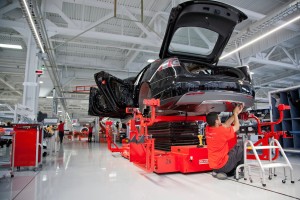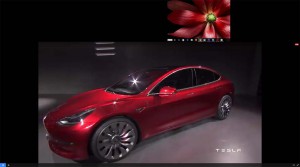
Tesla will pause production at its plant in Fremont, California, to prep for the Model 3, which is expected to come online later this year.
Tesla has confirmed it will briefly “pause” production at its Fremont, California, assembly plant this month as it begins the process of tooling up for the all-new Model 3 battery-sedan scheduled to come to market later this year.
The Model 3 is, arguably, the most critical model that Tesla will bring to market since it rolled out its original Roadster early this decade. Expected to deliver at least 200 miles per charge, but at a price tag barely half that of the current Tesla Model S sedan, the new EV has generated about 400,000 advance reservations, according to Tesla.
But industry analysts warn that the company needs to ensure the Model 3 comes to market on time and with the sort of quality that mainstream buyers expect.
“Tesla will begin a brief, planned pause in production for a week in February to prepare for Model 3 production,” a spokesperson said in an e-mail response to questions from TheDetroitBureau.com. “During this time, we plan to add capacity to the existing paint shop so that it is ready for Model 3, and perform general maintenance on other factory equipment.”
(Musk and Trump: Strange bedfellows indeed. Click Here to find out why.)
The week-long shutdown is not expected to “have a material impact” on overall, first-quarter production or deliveries, the Tesla official added, noting that additional work days have been added to the January-March schedule to make up for any losses.
Tesla last year struggled to meet its initial production and sales targets. It faces even more challenges going forward. Following the unveiling of the Model 3 at its California unveiling last March, Tesla CEO Elon Musk outlined aggressive growth plans for the company, forecasting it would be selling 500,000 vehicles annually by 2018, or roughly 10 times more than it moved in 2015.
The shutdown, said the company’s statement, “will allow Tesla to begin Model 3 production later this year as planned and enable us to start the ramp towards 500,000 vehicles annually in 2018.
The automaker almost immediately logged 300,000 reservations, each accompanied by a $1,000 deposit. That number, according to Tesla, grew to more than 400,000 by late spring.
(Click Here to see more about the feds clearing Tesla and Autopilot.)
Industry analysts say the Model 3 could transform Tesla from a generally loss-generating niche player into a more mainstream competitor – while also transforming the battery-electric market from a narrow niche into a serious alternative to conventional, internal combustion technologies.
But they also warn that Tesla will have to cope with a different kind of buyer. “They are more demanding,” Stephanie Brinley, auto analyst with IHS Automotive, said, a lot less willing to tolerate quality problems than the affluent buyers of Tesla’s current Models S and X.
Tesla has been intentionally vague about the precise timing of the Model 3 launch, giving the company a little leeway if the factory conversion process proves more difficult than anticipated. But it is widely expected that pilot versions of the new battery-sedan will begin rolling down the Fremont assembly line by July. It will take several months, most observers believe, before production-quality versions are ready to ship to dealers.
Tesla faces other challenges as it gets ready to launch the Model 3. CEO and founder Musk has been taking sharp criticism from some of his proponents for his decision to join the economic advisory panel set up by President Donald Trump. Musk has defended that move by saying it gives him the opportunity to influence the new president on issues such as global warming. Tesla has also filed an amicus brief opposing Trump’s immigration ban.
(Tesla misses mark on deliveries. Click Here for details.)
Nonetheless, Tesla has been hit by some critics who have cancelled Model 3 reservations. Tesla declined to comment on that boycott, but various reports have suggested that the number of vehicles affected run anywhere from the hundreds into the thousands.

